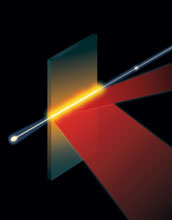Multimedia Gallery
High-brightness Coherent Soft X-ray Laser Beams
Schematic representation of the generation of intense, highly coherent, soft X-ray laser pulses (left) by the amplification of a small seed of coherent soft X-ray light (right) into a hot plasma amplifier created by irradiating a solid target with powerful optical laser beams (in red).
More about this Image
Recent advances in laser research allow the generation of intense laser light in the "soft X-ray" region of the electromagnetic spectrum, at wavelengths 50 times shorter than visible light. This type of new compact laser is of great interest in nanotechnology and other fields because it can be used to resolve tiny features, create extremely small patterns, and explore materials in ways that visible light cannot. However, soft X-ray light waves are usually not in phase (coherent) during the brief time available for resolving features for as long as many widely used visible light lasers are.
In results of an experiment, Colorado State University researchers from the National Science Foundation Engineering Research Center (ERC) for Extreme Ultraviolet (EUV) Science and Technology have demonstrated a way to dramatically improve the coherence, and therefore the quality, of laser light at extremely short wavelengths. To produce bright beams of soft X-ray laser light with practically perfect coherence, the team first generated a short-duration pulse or "seed" of coherent X-ray light by converting the frequency of a visible laser beam to soft X-ray light, yielding a very coherent light at a low intensity. Subsequently, that light seed was injected through a plasma amplifier and magnified to produce a very high-intensity beam of soft X-ray light with extraordinarily high coherence.
This breakthrough into highly coherent, compact, soft X-ray laser sources opens new scientific and technological opportunities in small laboratory environments and covers the generation of laser light at wavelengths near 13.5 nanometers--a wavelength particularly valuable for measurements in the semiconductor manufacturing industry, which aims to print the next generation of faster computer chips using that wavelength of light. Other exciting applications include the demonstration of ultrahigh-resolution microscopes and the direct patterning of large arrays of nano-devices. [Research supported by NSF grant EEC 03-10717.] (Date of Image: 2008)
Credit: Jorge Rocca, Colorado State University
Images and other media in the National Science Foundation Multimedia Gallery are available for use in print and electronic material by NSF employees, members of the media, university staff, teachers and the general public. All media in the gallery are intended for personal, educational and nonprofit/non-commercial use only.
Images credited to the National Science Foundation, a federal agency, are in the public domain. The images were created by employees of the United States Government as part of their official duties or prepared by contractors as "works for hire" for NSF. You may freely use NSF-credited images and, at your discretion, credit NSF with a "Courtesy: National Science Foundation" notation.
Additional information about general usage can be found in Conditions.
Also Available:
Download the high-resolution JPG version of the image. (1.4 MB)
Use your mouse to right-click (Mac users may need to Ctrl-click) the link above and choose the option that will save the file or target to your computer.

